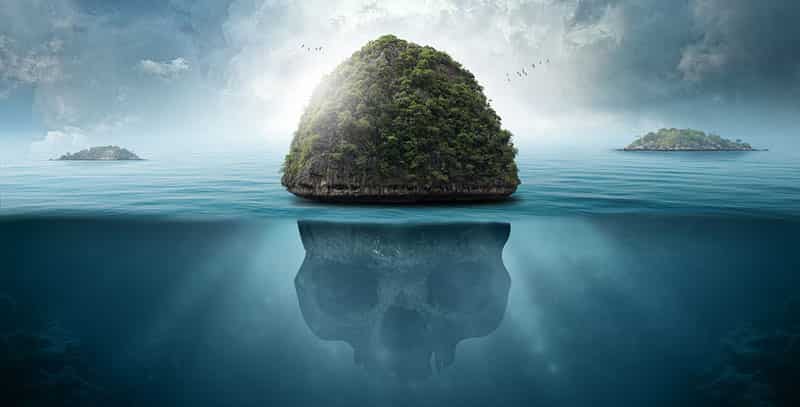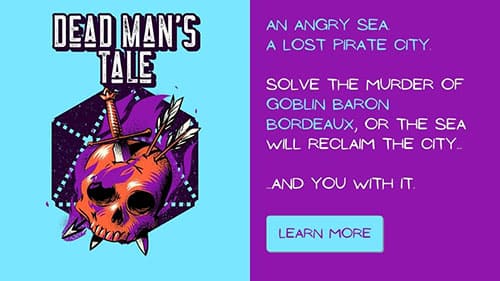When creating an original island adventure in DnD 5e or other tabletop RPGs, consider the following:
- Try ship mechanics and layout from Ghosts of Saltmarsh.
- Underwater adventures and combat rules.
- Lean into survival on distant islands.
- Consider monster ecology: beach, underwater, jungles.
- Social encounters: natives, pirates, explorers and spirits
- Island dungeons, ruins and temples
Island adventures in Dungeons and Dragons 5e create opportunities for sailing, lost worlds, underwater excursions and pirate campaigns. Obviously, this type of campaign will be full of aquatic monsters, hidden temples, lush jungles and booby traps. Do the locals practice an unknown magic connected to the sea? Or has a pirate city formed amid an island chain?
Before we dive into homebrewing an island adventure, you can check out my original homebrew pirate adventure here or below!
No matter the set up and overarching story, island campaigns have several mechanics to consider. We want to vary gameplay with monster encounters, social encounters and exploration. Therefore, mechanics like the ship crew of Ghosts of Saltmarsh and underwater combat can add to the adventure and make it unique.
Try ship mechanics and layout from Ghosts of Saltmarsh.
Ghosts of Saltmarsh is a great place to start for campaigns that utilize a traditional ship crew and structure. In this release from Wizards of the Coast, we receive game mechanics for ship combat, crew management and even mutiny. This book goes in deep, so if this is your thing, I would recommend it.
Ship Mechanics and Crew
Ships have AC, Dexterity and HP, and come in several sizes. Large galleys, sailing ships and warships can carry many crew members, including the party.
In combat, the ship itself rolls for initiative, alongside the party. The ship adds its Dexterity score (not good) as well as the day’s Quality Score.
Quality Score
Starting out, my ship will receive +4 to my Quality Score, ranging from -10 to +10. I’ll need to secure victories, lost treasure, shore leave, good vibes or the ship’s quality score is affected negatively. Once this hits 0 or lower, the Captain must make an Intimidation or Persuasion score to the crew and add the quality score.
If the roll is greater than 9, nothing bad happens.
A roll of 1-9 subtracts an additional -1 from quality score.
However, a score less than 9 causes mutiny.
Crew
While on board, players will fill out certain rolls for the ship as laid out in Ghosts of Saltmarsh. Therefore, playing this style will set me and my friends into rolls ranging from Captain to Cook. These rolls are:
- Captain: The leader and shot caller. This can be an NPC or player.
- First Mate: The connection between captain and crew. Also, another charismatic leader.
- Boatswain: Ship fixer and mechanic.
- Quartermaster: In charge of nautical charting, navigation and maps
- Cook: Just here to cook stuff. However, cooks must do the best they can with what they have. Cooks can also bring up morale.
- Crew: The crew is the element of the game that affects the Quality Score. The crew is important for ship actions and maneuverability. Less than 40 and we’re looking at trouble. Plus, crew members can be lost when the ship takes damage—and mutiny is always a possibility.
Ship Combat Actions
Ships have a number of actions that depend on the type of ship and amount of crew on board. Therefore, if a ship loses crew members to combat or mutiny, the ship loses combat actions. Naturally, this makes the ship more prone to sinking or capture. Also, some actions depend on ship upgrades—such as upgrading from oars to sails—or are related to certain ships.
These actions include maneuvers and weapons such as:
- Control Helm—turn 90 degrees after moving the speed of one of the ships components.
- Movement: Oars—speed (water) 30 feet, requires at least 40 crew members. AC: 12, HP: 100-lose 10 feet of speed per 25 damage.
- Movement: Sails—speed (water) 35 feet, 15 feet against the wind, 50 feet with the wind. AC 12, HP 100- lose 10 feet of speed per 25 damage.
- Weapons: Ballista—ranged 120/480, +6 to hit, 1 target, 3d10 piercing damage. AC:15, HP: 50.
- Weapons: Mangonels—ranged 200/800, can’t hit targets within 60 feet of it, +5 to hit, 1 target, 5d10 bludgeoning damage.
- Weapons: Naval Ram—melee, advantage on saving throw related to crashing the ship into a creature or object. The ram takes the damage instead of the ship. These rules don’t apply when another ship crashes into the galley.
Underwater adventures and combat rules
Playing island adventures in DnD 5e means learning the rules of water. If there’s one thing prevalent in the story of island hopping, it’s the ocean. Whether an encounter drags one of the players beneath the surface or the whole quest requires water breathing, we need to think about what we can do with these mechanics to spice up the campaign.
Underwater Combat
First, let’s go over what we can do in a combat scenario—a player is dragged underwater by a lurking creature.
Underwater, a player that doesn’t have a swimming speed, either natural or magical, has disadvantage on attack rolls. However, a knife, javelin, shortsword, spear or trident attack as normal. Ranged attack automatically miss when they go beyond their initial range. Even within their range, they gain disadvantage unless fired from a crossbow or thrown like a javelin or net.
Naturally, everyone has resistance to fire damage.
Then, we should look at the rules for grappling, which is a possible combat tactic for a helping friend.
Grapples can be attempted as an attack. Therefore, if I have a character with an Extra Attack feature, one of those attacks can be a grapple. The grappling character makes a Strength check against an enemy’s Strength or Dexterity check. A grappled opponent’s speed is reduced to 0 while grappled. However, they can attempt a Strength or Dexterity check on their turn to escape.
Creatures 1 size larger than the grappler automatically escape the grapple on their turn.
A player with the Grappler feat gains special abilities while grappling, including:
- Advantage on grappling attack rolls
- Make another grapple attack roll and pin the target. Both player and target are restrained.
- Creatures 1 size larger no longer automatically succeed on escaping the grapple next turn.
Underwater Adventures
There are many ways to give a character water breathing—through spell casting, magic items or an amphibious nature. So, when the party realizes that everyone can breathe underwater, new adventure options appear. Now, the party can explore underwater caverns, sunken vessels, lost cities or the wilds of an exotic reef.
Consider these prompts for underwater adventures or excursions:
- Sunken Ship: Buried with treasure at the bottom of the sea, a classic sunken ship adventure could bring elements of ghosts and local predators. A legendary pirate’s sunken vessel may hold cursed items, magic items, treasure or the vengeful spirits of the crew. Consider stalking creatures like sharks or any given tentacled horror in the 5e Monster Manuel.
- Lost Civilization: Use the Atlantis trope to introduce the party to an underwater civilization. Potentially triton or sea elf, this civilization could launch any number of other underwater quests. Plus, this gives an extra social opportunity in an isolated setting.
- Reef Exploration: Use the underwater wilderness as a setting for an adventure. The party could be on the hunt for a special herb or pearl within a vast coral reef. Giant, colorful coral structures and an assortment of strange fish and aquatic life could make a fascinating setting. How would a survival situation play out underwater?
- Cavernous Lair: The party takes on a bounty, hunting a dreaded predator in its own underwater layer—Beowulf style. Underwater caves can mix strange subterranean creatures like cave fishers with aquatic monsters like darkmantles. Then, a much larger monster can be the big boss fight.
Lean into survival on distant islands.
An inherent theme in island adventures is isolation. Whether the island itself is a lost, mythological wonder or just too far offshore for most people to care about, islands are lonely and vulnerable. Natural disasters like storms, tsunamis and volcanic eruptions are common with this setting. Therefore, any number of survival situations can occur.
Even when civilizations do arise on islands, they are often varied and may not be friendly to outsiders.
Natural Obstacles—Geography
Consider natural obstacles that may occur on wild islands. Sure, the wildlife may reign supreme on the uninhabited landmass, giving plenty of opportunity for monster encounters. But pitfalls can make the game more interesting, so the players aren’t fighting one battle after another.
Common island ecologies that come to mind are temperate, rocky landscapes or tropical and volcanic. Consider these pitfalls during excursions into the island wilds:
- Quicksand: Marshes and mangroves near the coast can create conditions for soft spots in the ground. Give your adventurers the layout of a marsh—a tabletop map or layout can help with this encounter. Players can roll a Survival check to see where to step. Then, those who fail the Survival check must make a Dexterity check or sink into the ground.
- Jungles: The nature of a true jungle means dense, rapidly growing vegetation. This means cutting through difficult terrain and potential ambushes from plant monsters. I could even create a thorny mess for players to be trapped inside that deals 1d6 piercing damage on failed Dexterity saves.
- Volcanoes: An impending eruption can cause earthquakes, lava rivers and wildfires. This can add an element of tension in adventures—a countdown for total annihilation. Plus, dodging hot lava can be a fun adventure all on its own.
- Cliffs: Coastal cliffs, volcanic mountains and waterfalls create opportunities for climbing (Athletics) checks and rock hopping. In fact, I could mix in other Athletics and Acrobatics checks with creative rope work as an obstacle course.
Natural Se Disasters—Storms and Tsunamis
Islands often must deal with the sea—it gives and takes away. Hurricanes and tsunamis can devastate island communities, who build a lifestyle in reverence of this threat. Similar to the volcano, an impending mega storm or tsunami can increase the tension of the adventure.
However, storms can come into play in different ways.
- Find Shelter: Players may be deep in the jungle when an oncoming storm hits. The simplest use of a storm forces players to find a cave or create their own shelter. This gives opportunities for players to get creative.
- Affect Ranged Attacks: If players are attacked during a storm, arrows are going to have a hard time flying in the windy environment. Ranged attacks will get disadvantage.
- Flash Floods: On a jungle floor or in a valley, the earth may overflow with a heavy downpour. A sudden flash flood can create crashing new streams that threaten to drown those without water breathing.
Consider monster ecology: beach, underwater, jungles.
Islands can produce unique collections of monster encounters, depending on the ecology. While some creatures will stalk on the coast, other mysterious creatures lurk in the deep jungles. Plus, the oceans between islands are sure to be swimming with tentacled horrors and gigantic leviathans.
Ocean monsters will change depending on the depth of the water. Out in the deep blue, all bets are off—this is where the big monsters lurk. However, coastal waters and sandbars may not support big creatures.
- Darkmantle, giant octopus, kraken—tentacles that can grab players and pull them underwater.
- Sharks, whales
- Merfolk, kuo-toa, merrow
- Turtle Dragon
- Aboleth
- Plesiosaurus, hydra
- Water elementals
Beach monsters include crab-like creatures and smaller monsters who avoid the larger predators of the deep island. However, it can also hold creatures who invade from the sea.
- Sea Hags
- Harpy
- Kobolds, lizardfolk
- Merfolk and merrow from the shallow sea
- Sahuagin raiders from the sea
- Air elementals
The deep jungle can carry prehistoric creatures and unknown horrors who haven’t seen an outsider in eons. We can mix in ideas from The Lost World and King Kong with typical rainforest creatures.
- Dinosaurs: Triceratops, allosaurus, T-rex…
- Tarrasque—if you want a Kong: Skull Island vibe with a 50-foot-tall bipedal lizard monster.
- Naga, Medusa, Yuan-ti—you know, snake people.
- Froghemoth, bullywugs and other frog monsters
- Blights, Shambling Mound, Treant—when the jungle itself comes to life.
- Specters, zombies—pirate style.
- Catoblepas and other stinky swamp creatures
- Firenewts, salamanders, earth elementals near a volcano
Social encounters: natives, pirates, explorers and spirits
Of course, not all islands belong completely to the wild. Civilizations and cultures appear on islands in unique ways. Often, especially with archipelagos and island chains, diverse cultures work in unison with each other across different islands.
Related Posts:
Guide to Building a Ranger Hunter: DnD 5e
| Guide to Building a Tabaxi Character: DnD 5e
|
Plus, we can consider other types of social interaction even when the island is uninhabited. Explorers, pirates and even spirits of a lost civilization can make for interesting social encounters along the way.
Consider the following island social encounter prompts:
- Another group of adventurers meets you at the mouth of an ancient temple in the overgrown jungle.
- A pirate crew boards your vessel. Now, the players must negotiate with the captain.
- Inside the lost temple, an ancient spirit pleads with the party not to enter the next floor. This can help build tension for the lurking monster inside.
- The party finds a kingdom of wood elves or forest gnomes who found their way to the island through a Feywild gate. Naturally, they live in connection with the wild, so the party wouldn’t notice until stumbling upon it.
- A small village of lizardfolk natives encounters the party at the coast, harboring warnings about the island volcano and jungle monsters.
Island dungeons, ruins and temples
Islands often carry the remnants of ancient civilizations, even if the land is now abandoned. The sea may entice the inhabitants to explore further, leaving great structures behind for the jungles to overtake. In fact, this is fantastic place to build an Indiana Jones style tomb crawler, complete with booby traps and snakes.
Consider these island dungeon crawls as an adventure prompt:
- A Yuan-ti priestess and her snake minions have claimed ancient ruins as a hideout. Now, the party has been hired by local druids to stop this priestess before she completes a heinous ritual and overruns the island in snake monsters. Volo’s Guide to Monsters has an in-depth chapter on Yuan-ti hideouts that I would recommend.
- A valuable artifact can be found deep within a volcanic cave. However, the volcano has been spitting lava lately. Does the party dare risk a quest through a subterranean cave system webbed with rivers of lava? This can be a fantastic opportunity for fire monsters like firenewts and fire breathing salamanders.
- An undersea temple holds an ancient trident of power, with a band of merfolk and merrow fish creatures in search of this temple. Now, the party must quest through giant coral fields and underwater landscapes to beat this band of merfolk to the temple and collect the trident.
- A maniacal wizard has built a tower that transforms sunlight into deadly heat rays, firing from the sky on his personal flying island. The players must run through a towering labyrinth with strange traps and magic trickery. Automatons, mimics and animated armor protect the interior, with the wizard at the top.





Thank you for this guide, I am sure this will come in handy as my campaign starts out on a tropical island 25 years after a cataclysmic event. The PCs are about to head into the deep jungle towards an ancient inactive volcano and I found this just in time!
Look forward to reading more of your work.
Regards,
Ian. H.R